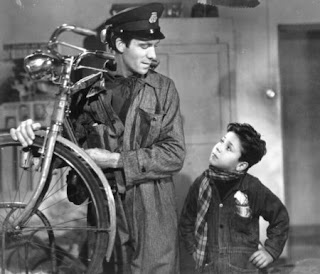I went to see
Hugo this weekend (great film, by the way) & I was set on not watching that movie in 3-D, which was hard because the only movie theater within a 15 mile radius had only two showings of the "2-D" version on Saturday. Every other theater had the 3-D version of the film, which I will not support & here are my reasons why.
For me, the 3-D image doesn't add anything to my movie experience. If anything, it takes away from it. I feel less immersed in the cinematic world because I'm aware that I'm in a theater. The best part about a film is getting sucked in, but with digital images flying at my face & pictures that look like I'm looking through a tunnel book, I fully aware that I'm in a moldy theater seat. For them to be called 3-D films & 2-D films is faulty. Films have always been in three dimensions. They've always contained depth & texture & we were watching movies just fine before 3-D came along.
There is something to be said about the flatness of the screen. It allows us to view the depth of the real world, but the picture's flatness allows us to get more involved in the narration, otherwise, it would be like seeing a play, where you're more aware of the reality of the real world. Psychologist Hugo Münsterberg wrote in 1916 about the pros of film's flatness. "We want to keep the interest in the plastic world & want to be aware of the depth in which the persons move, but our direct object of perception must be without the depth. That idea of space which forces on us most strongly the idea of heaviness, solidity & substantiality must be replaced by the light flitting immateriality." This flatness is a plus, not something that needs to change.
 |
| Good Movies Always Come in 3-D |
Also, I don't like they way it alters the picture. The projectors for 3-D movies have to be dimmer for 3-D projectors & changing a 3-D projector to a 2-D projector requires a specialist to come to the theater, which cost thousands of dollars, so the theaters just keep them at their 3-D setting, making all films dimmer. Remember the time when the film could light up everyone's face in the theater, now it's a glow. Check it out next time you're at the movies.
Also, it's just another way for the studios to get extra money out of you, particularly if they're cheaply made 3-D films or animated films. Films like
Avator or
Hugo were shot with a 3-D camera that is highly technical & thus, highly expensive, making the hiked price a little understandable, but only a little. But for old 3-D films & newer films like
Clash of the Titans, the film is sent overseas to digitally cut the film and layer it. That's why those films look like a science project diorama. You're paying for a poor product. As for animated movies, all they have to do is change a code, which is why all the animated blockbusters now are in 3-D, because it cost no extra money to make them that way.
You can keep on going to 3-D movies & I won't judge you, just do some research before you see a film & decide if the extra cash is worth it. But I will say this, if you badly need physical reality for your stories, go to a play & if you really want motion-sickness & objects flying at your face, go on a roller coaster.
 The Triplets of Belleville is a French animated film by Sylvain Chomet that follows a grandmother & her grandson, who has the dream of winning the Tour de France. During the race, a pair of blocky, suited men kidnaps the grandson. The grandmother & her dog follow the kidnappers all the way to Belleville, a grand metropolis at the other end of the ocean. In a unknown land, the pair get help from the Triplets of Belleville, an aged singing group from the 30's, now poor & left with eating frogs. They find out that the grandson was kidnapped by a mobster who created an underground gambling ring with bicyclists' endurance & life being bet on.
The Triplets of Belleville is a French animated film by Sylvain Chomet that follows a grandmother & her grandson, who has the dream of winning the Tour de France. During the race, a pair of blocky, suited men kidnaps the grandson. The grandmother & her dog follow the kidnappers all the way to Belleville, a grand metropolis at the other end of the ocean. In a unknown land, the pair get help from the Triplets of Belleville, an aged singing group from the 30's, now poor & left with eating frogs. They find out that the grandson was kidnapped by a mobster who created an underground gambling ring with bicyclists' endurance & life being bet on.
















































